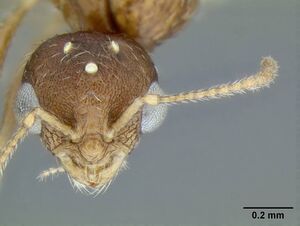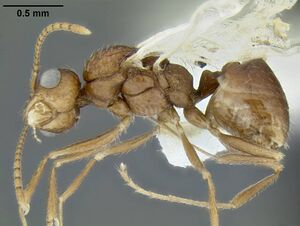Temnothorax nuwuvi
| Temnothorax nuwuvi | |
|---|---|

| |
| Scientific classification | |
| Kingdom: | Animalia |
| Phylum: | Arthropoda |
| Class: | Insecta |
| Order: | Hymenoptera |
| Family: | Formicidae |
| Subfamily: | Myrmicinae |
| Tribe: | Crematogastrini |
| Genus: | Temnothorax |
| Species group: | sallei |
| Species: | T. nuwuvi |
| Binomial name | |
| Temnothorax nuwuvi Snelling, Borowiec & Prebus, 2014 | |
Nothing is known about the biology of Temnothorax nuwuvi.
Identification
Prebus (2017) - A member of the sallei clade.
Snelling et al. (2014) - Head sculptured with longitudinal rugae anastomosing into reticulation on sides; petiole node robust and subtriangular in profile with rounded summit; propodeal spines acute and relatively short; dark reddish brown.
The combination of brown body color with relatively coarse head sculpture, weakly sculptured postpetiole dorsum, non-acute petiole node and postpetiole more than 1.5 × as wide as long in dorsal view will serve to distinguish this species from other Temnothorax occurring in the area. With regard to color and sculpture, T. nuwuvi is similar to Temnothorax nevadensis. The latter is a very variable species, but the combination of less robust petiolar node, postpetiole relatively more narrow, and longer propodeal spines in T. nevadensis (PI 129–147, PSI 16–26 in nevadensis vs. PI 154–176, PSI 10–17 in nuwuvi) will serve to distinguish the two.
Keys including this Species
Distribution
Latitudinal Distribution Pattern
Latitudinal Range: 38.788264° to 38.5°.
| North Temperate |
North Subtropical |
Tropical | South Subtropical |
South Temperate |
- Source: AntMaps
Distribution based on Regional Taxon Lists
Nearctic Region: United States (type locality).
Distribution based on AntMaps
Distribution based on AntWeb specimens
Check data from AntWeb
Countries Occupied
| Number of countries occupied by this species based on AntWiki Regional Taxon Lists. In general, fewer countries occupied indicates a narrower range, while more countries indicates a more widespread species. |

|
Estimated Abundance
| Relative abundance based on number of AntMaps records per species (this species within the purple bar). Fewer records (to the left) indicates a less abundant/encountered species while more records (to the right) indicates more abundant/encountered species. |

|
Biology
Castes
Worker
     
| |
| . | |
Male
  
| |
| . | |
Nomenclature
The following information is derived from Barry Bolton's Online Catalogue of the Ants of the World.
- nuwuvi. Temnothorax nuwuvi Snelling, Borowiec & Prebus, 2014: 57, figs. 11–12, 19, 23–24 (w.m.) UNITED STATES.
Unless otherwise noted the text for the remainder of this section is reported from the publication that includes the original description.
Description
Worker
measurements (mm) (40 measured): EL 0.163–0.196 (0.180); HFL 0.540–0.650 (0.583); HFW 0.098–0.147 (0.127); HL 0.646–0.771 (0.701); HW 0.532–0.662 (0.586); IOD 0.459–0.558 (0.504); OMD 0.141–0.184 (0.159); PPW 0.302–0.367 (0.328); PSL 0.066–0.118 (0.093); PTW 0.179–0.228 (0.200); PW 0.387–0.502 (0.430); SL 0.519–0.610 (0.554); WL 0.793–0.977 (0.867). Indices: CI 78.7–96.8 (83.6); FI 84.0–107.9 (99.5); OI 23.5–27.8 (25.7); PI 154–176 (164); PSI 9.9–16.9 (13.2); SI 74.6–84.8 (79.1).
Head longer than broad in frontal view, lateral margins very weakly convex, posterior margin flat to very weakly convex. Antennal scape just outreaching posterior margin; apical club distinctly 3-segmented. IOD 2.53–3.02 × EL; EL 0.99–1.27 × OMD. Mandible finely longitudinally rugose. Clypeus with 1 or 2 short fine carinae on either side of median carina. Dorsum of head with irregular longitudinal rugae, interspaces from mostly smooth between rugae along dorsum midline to contiguously reticulate laterally; malar area with several short fine longitudinal rugae, interspaces dull and sharply reticulate; posterolateral angles of head moderately shiny and weakly reticulate. Dorsum of head with relatively dense, blunt setae.
Mesosoma slender, WL 1.78–2.11 times longer than PW; mesosomal dorsum weakly convex in profile, sloping down to sharp propodeal spines. Mesosomal dorsum moderately rugose with corrugated interspaces and the corrugation faintest medially on pronotum; side of pronotum coarsely rugose, interspaces inconsistently corrugated; posterior face of propodeum dull and reticulate. Metafemur 4.26–5.38 times longer than wide in dorsal view. Entire length of dorsum with 20+ blunt setae that are distinctly longer than those of frons. Petiole with only very short anterior peduncle; node robust and subtriangular, no higher than thick, summit flattened; subpetiolar tooth short and acute. Postpetiole profile low; in dorsal view node 1.54–1.76 times width of petiole node. Petiole coarsely rugose laterally and dorsally with interspaces corrugated and anterior face reticulate; postpetiole with much weaker rugosity laterally and posteriorly, with semi–regular corrugation transitioning to fading reticulum dorsally; dorsum of postpetiole can be relatively smooth, but traces of reticulum can be seen in most specimens. Petiole with 6–8 setae similar to those of mesosoma and postpetiole with 14–16 setae.
Gaster in dorsal view 1.93–2.36 times wider than postpetiole node; surface of first tergite smooth and shiny between sparse piligerous punctures; surface with sparse suberect flattened setae similar to those of mesosoma and scattered finer prostrate pubescence.
Head and body dark brown.
Male
Male measurements (mm) (2 measured): EL 0.221–0.234 (0.228); HFL 0.673– 0.685 (0.679); HFW 0.085–0.094 (0.090); HL 0.422–0.485 (0.454); HW 0.502– 0.503 (0.502); IOD 0.377–0.397 (0.387); OMD 0.073–0.081 (0.077); PPW 0.231– 0.236 (0.233); PSL N/A; PTW 0.147–0.161 (0.154); PW 0.519–0.623 (0.571); SL 0.164–0.178 (0.171); WL 0.936–0.973 (0.955). Indices: CI 104–119 (111); FI 134– 136 (135); OI 45.6–55.5 (50.5); PI 147–157 (152); PSI N/A; SI 33.8–42.2 (38.0).
Head broader than long, margins behind eyes slightly convergent and broadly rounded into slightly convex posterior margin. Eyes large and strongly bulging; IOD 1.70–1.71 x EL; OMD very short, about equal to transverse diameter of anterior ocellus; interocellar distance 3.30–3.50 and ocellocular distance 3.60–4.10 times diameter of anterior ocellus. Antennae 13-segmented. Scape less than half of IOD. Head dull, mostly reticulate with few longitudinal rugae near frontal carinae and ocelli. Dorsum of head with about a dozen erect, relatively long and pointed setae, those setae are located mostly on posterior half of head dorsum, and on vertexal margin behind ocelli.
Mesosoma robust, WL 1.56–1.80 × PW. Sculpture pronounced. Entire pronotum reticulate. Most of mesoscutal dorsum shagreened, and mesoscutellum medially smooth. Mesoscutum with >30 suberect short, slender setae; four pairs of longer setae submedially on metanotum. Small propodeal tubercles present. Entire propodeum reticulate with weak rugosities near the tubercles.
Summit of petiole node low, angular in profile; subpetiolar process absent.
Body brown with gaster and appendages lighter.
Type Material
Holotype worker, U.S.A.: NEVADA: Nye Co.: Mount Jefferson, 2895 m, 38.7° -116.9°, 7.viii.1976 (G. C. Wheeler & J. Wheeler) (LACMENT299376) Los Angeles County Museum of Natural History. Paratypes. Same data as holotype paratype, 2 workers (LACMENT299381) Museum of Comparative Zoology, 2 workers (LACMENT299380) [USNM], 2 workers (LACMENT299379) LACM, 2 workers (LACMENT299378) [LACM], 2 workers (LACMENT299377) LACM, 3 workers (LACMENT299375) [LACM], 2 workers (LACMENT299386) University of California, Davis.
Etymology
The name “Nuwuvi” is the Southern Paiute name for themselves; it means “the People” or the true men.
References
- Snelling, R.R., Borowiec, M.L. & Prebus, M.M. 2014. Studies on California ants: a review of the genus Temnothorax (Hymenoptera, Formicidae). ZooKeys 372:27–89. doi:10.3897/zookeys.372.6039
References based on Global Ant Biodiversity Informatics
- Snelling R.R., M. L. Borowiec, and M. M. Prebus. 2014. Studies on California ants: a review of the genus Temnothorax (Hymenoptera, Formicidae). ZooKeys 372: 2789. doi: 10.3897/zookeys.372.6039

